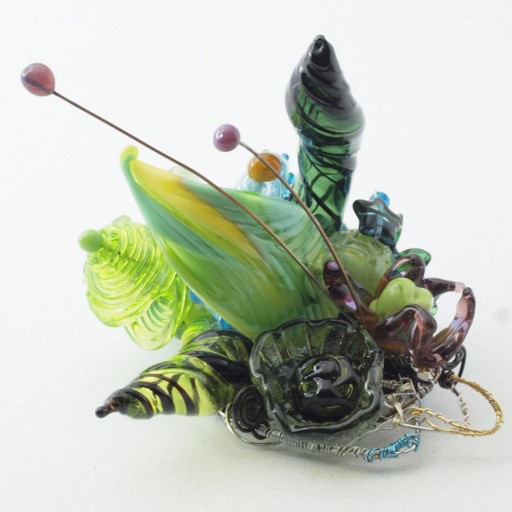There are several elements to a good class; and one desirable but often not obtainable goal is to have (at least the bulk of) your students leave with a finished product. Often this just isn't possible, but I suspect one reason Sara Sally LaGrand's corsage class is a popular one with beadmakers (to judge by the many online examples I was able to find, not to mention the enthusiasm of the students in the workshop I attended) is that even if every single component you make fails, you can still do the assembly—since Sara also sells the various components. (Any class where you have the option of selling both finished examples and componsents/supplies/tools is also good—and Sally had plenty of both.)

approx 4x4x4 inches, and 125gm/4.5oz; glass, metal wire, polymer clay. assembled 15jan2012, mostly from ‘bead curtain’ beads.
From a teacher's point of view it's also desirable not to be teaching something so up to the minute that your student's creations interfere with your gallery sales: and I find it kind of interesting that LaGrand's work has also migrated to a scheme with highly repetitive elements, that easily distinguishes it from her students’ efforts of mixed components (the class has five distinct elements.)
Which brings me to the third reason this class works so well: it's very adaptable to the student's working style: don't like making the components she's teaching? Put your own thing on the end of the wire instead! So, the class accommodates all kinds of styles. As with most projects of this type, the simpler components—the long headpins with glass balls on the end and the ‘bud’ or pointed variant—were perhaps the most useful. Other components included the leaf/wing, the cup, the pointed cup and pointed cup with ball inside (i.e. eye). These latter items could be built on wire or mandrels, depending on the beadmaker's choice. I didn't have any of the black wire LaGrand recommends, so I substituted 308 welding wire (the same stuff is what our local beadmaking community prefers for mandrels.)

I have this leaf-texture masher—had it for years, in fact—and finally put it to good use with these mixed scrap leaves, one of which I incorporated in to this piece. Pictures/2012/20120117
Ironically I purchased this almost 30 years ago...to make pins! (Fibulas made of sterling silver happened to be one of my metalworking teacher Phillip Fike's[1] favorite bread and butter items; and it happens though Sally gave us commercial pinbacks, she also makes her own backs, and were I to pursue this, I would as well.) It just so happens the springy wire I purchased for metalworking also happened to be perfect for lampworking applications too;)
In my own case, of course, I wanted to do hollows. These corsages do have one major downside, that should be fairly obvious just looking at them: they're heavy. I made the leaf (before the class started, actually) and I think I used some shampoo lead czech for my ‘headpins’; I also managed a couple of pretty wonky (and very long) “buds”, but a lot of my beads were just scraps I incorporated in.

This view shows that big flattened aqua dottie I rather liked, even if it was a scrap bead. Image: 20120219
To keep the back of the pin tidy looking (and, incidentally provide a handy place to sign the work) LaGrand has her students cover the wire platform with polymer clay. Mine cracked something awful—not, because as I suspected it was stale, but simply because I failed to warm it sufficiently. In any event, I think these pins would be even more fun if the base wire could somehow be incorporated into the design, with decorative wirewrapping, which, if instead of being covered with beads, was allowed to show would also reduce the weight.
It's fascinating to contemplate, and I suppose I'll consider it...someday.
Meanwhile, as the final way to cap her workshop, Sara Sally Lagrand passed out a bunch of joke shop type goodies, including mustaches for everyone. The end of our session included a group shot wearing both these and our pins—we all felt silly, but bonded over it nonetheless.
As I said, excellent workshop—and a lot of fun!
06jun24 added wikipedia link to Fike's name;sculptural & year tags
[1]yes, that Phillip Fike
Unless otherwise noted, text, image and objects depicted therein copyright 1996--present sylvus tarn.
Sylvus Tarn